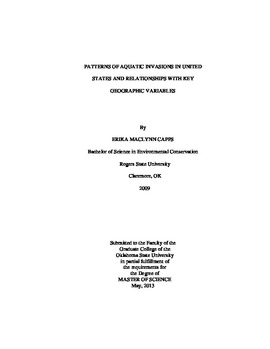| dc.contributor.advisor | Papes, Monica | |
| dc.contributor.author | Capps, Erika Maclynn | |
| dc.date.accessioned | 2014-09-24T14:17:56Z | |
| dc.date.available | 2014-09-24T14:17:56Z | |
| dc.date.issued | 2013-05-01 | |
| dc.identifier.uri | https://hdl.handle.net/11244/11073 | |
| dc.description.abstract | Invasive species are a serious threat to biodiversity, and the increasing spread of invasive species due to human transport and environmental change is only escalating the issue. In aquatic systems, the effects of human-induced environmental changes within watersheds have not been quantified in relation to the populations of aquatic invasive species (AIS). Moreover, given the potential effects of increasing numbers of AIS on native species, it is important to estimate the degree of spatial coincidence between AIS and key geographic variables.I performed a broad-scale spatial analysis of the distribution patterns of freshwater AIS of plants, vertebrates, and invertebrates for the contiguous United States to investigate distributional patterns and the density of AIS (number of invasive species per watershed area) in US watersheds, correlation of AIS diversity with geographic variables such as watershed distance to major ports of entry, dominant land cover, human population density, and mean nitrogen and phosphorus levels in watersheds, and to identify statically significant hotspots of invasion. I found that the density of AIS can be explained by distance to nearest port, human population density, percent open water, and the mean nitrogen level per watershed. Of the 2111 watersheds in this study, 64 watersheds were identified as statistically significant hotspots and 1351 watersheds were within 500 km of hotspots. These statistically significant hotspots, along with areas with a high number of AIS, should be evaluated for management purposes to help prevent further spread of AIS. | |
| dc.format | application/pdf | |
| dc.language | en_US | |
| dc.publisher | Oklahoma State University | |
| dc.rights | Copyright is held by the author who has granted the Oklahoma State University Library the non-exclusive right to share this material in its institutional repository. Contact Digital Library Services at lib-dls@okstate.edu or 405-744-9161 for the permission policy on the use, reproduction or distribution of this material. | |
| dc.title | Patterns of Aquatic Invasions in United States and Relationships with Key Geographic Variables | |
| dc.type | text | |
| dc.contributor.committeeMember | Baum, Kristen | |
| dc.contributor.committeeMember | Dzialowski, Andrew | |
| osu.filename | Capps_okstate_0664M_12773.pdf | |
| osu.accesstype | Open Access | |
| dc.description.department | Zoology | |
| dc.type.genre | Thesis | |
